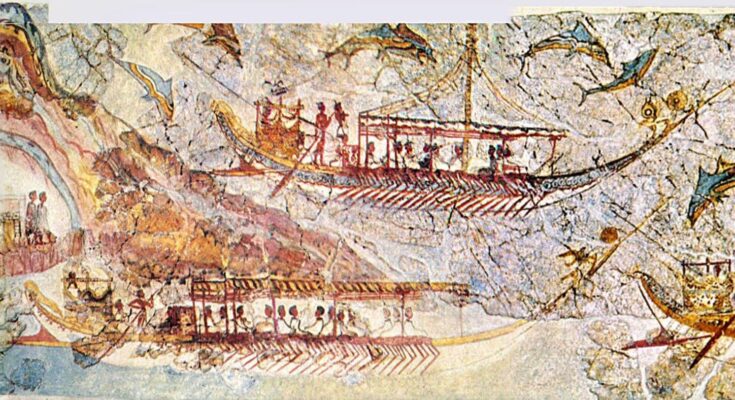How did the Minoan civilization on ancient Crete and the Cyclades come to an end? The single greatest factor involved was the conquest of Minoan Crete by the Mycenaeans. How and when did this conquest take place, and did it even really happen?
Relations between the Minoans and the Mycenaeans
The Minoan civilization dominated Crete and many of the Cyclades for much of the Bronze Age. It was mainly confined to the Middle Bronze Age. Archaeologists define this period as extending from approximately 2000 to around 1550 BCE.
During this era, there was extensive trade between the Minoans and Mycenaeans. Archaeologists have found numerous Minoan items of luxury among the Mycenaeans of that period, and vice versa. Genetic studies also reveal that the two peoples were closely related.
The archaeology of the Eastern Mediterranean as a whole from that era shows that the Minoans were the dominant trading force. While the Mycenaeans did engage in far-reaching trade, as well, Minoan Crete was much more prominent as a center of international trade.
The Mycenaeans conquer Minoan Crete
However, this relationship between the two peoples changed in the Late Bronze Age. This is the period from roughly 1550 to 1200 BCE, according to most archaeologists. About a century into this period, around approximately 1450 BCE, we see evidence of massive changes on Crete.
The most obvious archaeological evidence of social upheaval from this period are the destruction layers. Various important Minoan cities (including Knossos, the most powerful city) were destroyed at this time. We find such destruction all over the island.
Although earthquakes do happen on Crete, the destruction that we see in this period was clearly targeted. In many cases, only religious buildings or administrative buildings were destroyed, while surrounding structures remained untouched.
There is no doubt whatsoever that humans were responsible for these destruction events.
Internal conflict or external invaders?
The presence of man-made destruction events across Crete does not necessarily mean that the island was invaded. Why do many scholars conclude that Minoan Crete was conquered by the Mycenaeans?
The reason, in part, is that there is clear evidence that the Minoans were preparing for warfare in the decades leading up to this event. For example, this is evident from the construction of defensive walls. For centuries, the Minoans had not placed much value on the construction of grand walls for defensive purposes.
However, in the decades leading up to approximately 1450 BCE, the Minoans began constructing defensive walls with great fervor. They built defensive towers, dug new wells, converted living quarters into storage areas, and so forth. Everything indicates they were preparing for warfare.
If destruction events around 1450 BCE were the result of internal conflict, this does not satisfactorily explain the aforementioned evidence. With internal conflict, we would expect to see the building of defensive structures emerge concurrently with the destruction layers, but the former decidedly precedes the latter.
A seaborne invasion
The evidence makes it clear that Minoan Crete was conquered by outside invaders, such as the Mycenaeans. Since it is obviously unlikely that the invaders declared their intent to invade decades in advance, we can only conclude that fighting was already going on prior to around the year 1450 BCE, though evidently in a setting that left little to no archaeological evidence.
Therefore, the logical conclusion is that the Minoans were facing attacks at sea. This is evidently what led to their deciding to prepare for war. Supporting this conclusion is evidence from several Minoan islands.
One example is Kythera. This is an island which is right at the doorstep of southern Greece. However, rather than being controlled by the Mycenaeans, it was a Minoan settlement much like Crete. In the first part of the Late Bronze Age, the Minoan settlement on Kythera was destroyed.
At about the same time, Minoan settlements on Rhodes and Milos constructed defensive walls, suggesting they were under threat of attack. Undoubtedly, there was a powerful seafaring nation which threatened the Minoans during this period.
Mycenaeans, the conquerors of Minoan Crete
The fact that the Mycenaeans conquered Minoan Crete is made clear by this and other evidence. The evidence recounted thus far points to the probability that a powerful, seafaring nation must have been attacking the Minoans.
What other seafaring nations existed at that time that were powerful enough to go up against such a large trading empire? There are not many options. The Mycenaeans, being geographically closest, are unarguably the most likely culprits.
Consider the fact that the Minoan settlement on Kythera, right next to Greece itself, was destroyed a second time in the Late Bronze Age at about the same time as the destruction of Knossos and other Cretan cities.
Confirming the case is the fact that the material culture of the Mycenaeans emerges in substantial quantities on Crete just after the destruction of the Minoan cities.
Furthermore, the script utilized by administrative centers suddenly changed, as well. Previously, it had been Linear A, the script of the Minoans. However, after the destruction levels, it changed to Linear B, the script of the Mycenaeans. Without doubt, the evidence is clear that the Mycenaeans conquered Minoan Crete around the year 1450 BCE.



